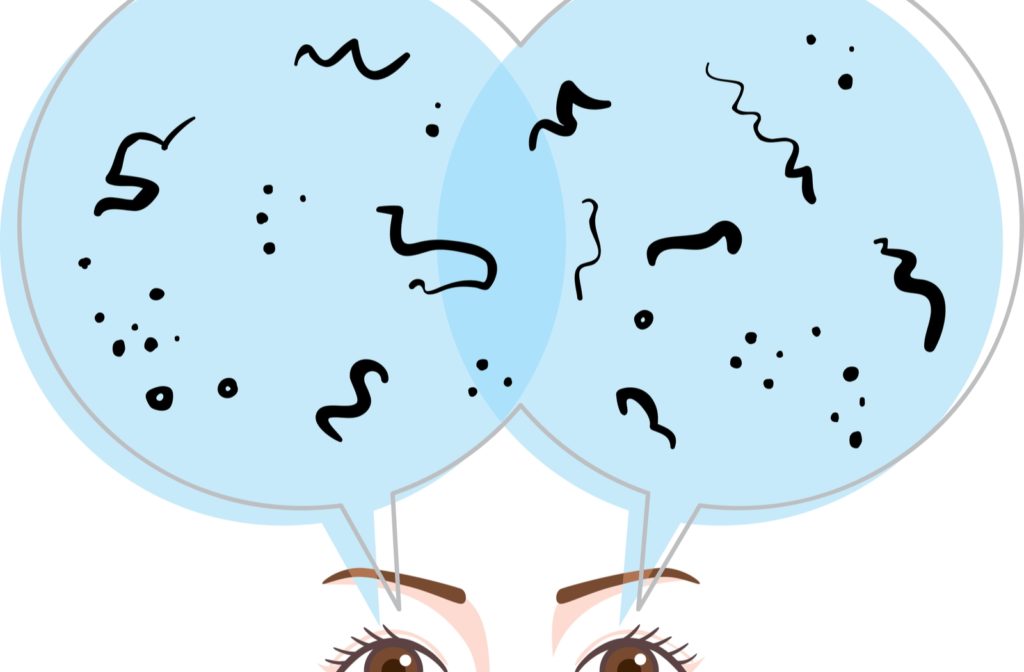Do you ever see squiggly little lines or grey specks in your vision? There’s a good chance these are eye floaters. Eye floaters are a common occurrence, especially as we age. But lots of floaters could indicate the presence of eye disease.
Don’t panic if you occasionally see floaters drift around your line of sight. Regularly scheduled eye exams are the best way to make sure that your eye floaters aren’t dangerous.
Let’s learn more about when you should worry about eye floaters and when they should be considered an eye emergency. As always, if you’re experiencing anything out of the ordinary with your vision, contact the eye doctors at Discover Eyecare in Abbotsford and Chilliwack.
What are Eye Floaters?
Eye floaters are spots, webs, or squiggles that appear in your field of vision. They often look like grey or black specks. Floaters follow your eye movements, but usually lag behind and float across your line of sight. They may look like objects in front of you but are actually inside your eye.
Our inner eye contains a jelly-like fluid known as vitreous. Vitreous is a clear substance that can allow particles and proteins to float through it. Eye floaters create the shadows we see when particles drift across your eye through the vitreous.
Symptoms of Eye Floaters
Simply put: eye floaters are small shapes that wander about your field of vision. The symptoms can be more specifically explained as:
- Small grey specks and squiggles that slowly move across your eye when you are looking at something
- Spots that float away when you try to look directly at them
- Shapes that are more noticeable against a plain bright background (like a bright sky)
- Webs and strings that settle across your line of sight and seem to disappear
Causes of Eye Floaters
Eye floaters are naturally occurring and are often a product of aging. As we get older, the proteins in our eyes break down and fibres within the vitreous become more visible, and drift through the eye’s fluid. When eye floaters are occasionally present and seem to be consistent in pattern, they can be normal.
Some people may be born with proteins or fibrous particles in the eye’s vitreous. These specks can remain in the fluid as the eye grows. Sometimes eye floaters can be confused with particles trapped under a contact lens. Other common reasons for eye floaters include:
- Being over the age of 50
- Nearsightedness (myopia)
- Diabetic retinopathy
- Eye inflammation
- Previous eye trauma
- Previous eye surgery

When to Worry About Eye Floaters & Eye Emergencies
Lots of new floaters or a sudden increase in eye floaters can be a sign that are more serious problems concerning your vision. An onslaught of floaters might be a sign of a retinal tear or detachment, and other complications that can lead to blindness. These types of floaters must be addressed immediately by an eye doctor.
If you experience any of the following symptoms in conjunction with eye floaters, contact your optometrists immediately for emergency eye care. These symptoms include:
- Loss of peripheral vision, a curtain or veil in your vision
- Very blurred vision or total loss of vision
- Sudden and frequent flashes of light
- Eye floaters increasing in intensity, size, and shape
- Sudden or steady eye pain
Eye Conditions Related to Floaters
The symptoms associated with several eye conditions can include an increase in eye floaters. When eye floaters are new, numerous and/or intense it’s best to have your eyes examined as soon as possible. The causes of sudden eye floaters can include:
- Retinal Tear: the vitreous capsule in our eyes shrinks and thins as we get older. This shrinkage can pull on the retina, sometimes leading to a tear. The retina is connected to the vasculature of the eye, and when torn, it allows fluid to leak through the hole, potentially leading to a detached retina.
- Retinal Detachment: when the retinal tissue becomes completely separated from the back of the eye, it’s known as a retinal detachment. Once this happens, light signals are no longer received by that retina and some vision loss occurs.
- Vitreous hemorrhage: is when bleeding occurs in the eye, appearing as floaters and shadows across your vision. This hemorrhaging may be the indication of other vision problems and should be addressed by an eye doctor immediately.
The reasons for hemorrhaging and retinal tears can include several things but are commonly associated with eye trauma, the presence of eye diseases, medical conditions, eye surgery complications, and eye, head, and facial injuries. Pay attention to eye floater activity if you have been exposed to these factors.
Know When to See Your Eye Doctor
Eye floaters are not always an eye emergency. Most people will experience some degree of floaters as they age and need not worry. But eye floaters can be a symptom of retinal tears or that emergency eye care is required. Although having floaters is normal, it’s best to rule out any underlying malicious causes first. Sudden and numerous eye floaters should also be considered an emergency.
Keeping your eyes healthy and spotting vision problems before the floaters arrive is best done with regularly scheduled eye exams. Value your vision and pay attention when those little squiggles float across your view.



